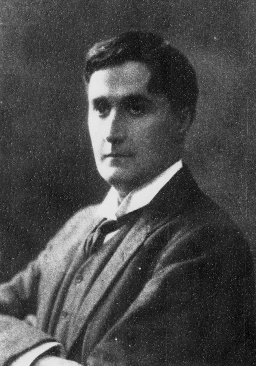
An acrostic is a poem or other word composition in which the first letter of each new line spells out a word, message or the alphabet. The term comes from the French acrostiche from post-classical Latin acrostichis, from Koine Greek ἀκροστιχίς, from Ancient Greek ἄκρος "highest, topmost" and στίχος "verse". As a form of constrained writing, an acrostic can be used as a mnemonic device to aid memory retrieval. When the last letter of each new line forms a word it is called a telestich; the combination of an acrostic and a telestich in the same composition is called a double acrostic.

"Be Thou My Vision" is a traditional Christian hymn of Irish origin. The words are based on a Middle Irish poem that has traditionally been attributed to Dallán Forgaill.

Dame Mary Jean Gilmore was an Australian writer and journalist known for her prolific contributions to Australian literature and the broader national discourse. She wrote both prose and poetry.
"The Water Is Wide" is a folk song of British origin. It remains popular in the 21st century. Cecil Sharp published the song in Folk Songs From Somerset (1906).

A Christian child's prayer is Christian prayer recited primarily by children that is typically short, rhyming, or has a memorable tune. It is usually said before bedtime, to give thanks for a meal, or as a nursery rhyme. Many of these prayers are either quotes from the Bible, or set traditional texts.
In English poetry, trochaic tetrameter is a meter featuring lines composed of four trochaic feet. The etymology of trochaic derives from the Greek trokhaios, from the verb trecho, meaning I run. In modern English poetry, a trochee is a foot consisting of a stressed syllable followed by an unstressed syllable. Thus a tetrameter contains four trochees or eight syllables.

The Five Mystical Songs are a musical composition by English composer Ralph Vaughan Williams (1872–1958), written between 1906 and 1911. The work sets four poems by seventeenth-century Welsh poet and Anglican priest George Herbert (1593–1633), from his 1633 collection The Temple: Sacred Poems. While Herbert was a priest, Vaughan Williams himself was an atheist at the time, though this did not prevent his setting of verse of an overtly religious inspiration. The work received its first performance on 14 September 1911, at the Three Choirs Festival in Worcester, with Vaughan Williams conducting.

"Come Again, sweet love doth now invite" is a song by John Dowland. The lyrics are anonymous. The song is bitter-sweet, typical of Dowland who cultivated a melancholy style.
When The Nightingale Sings is a Middle English poem, author unknown, recorded in the British Library's Harley 2253 manuscript, verse 25. It is a love poem, extolling the beauty and lost love of an unknown maiden.
Charlotte Alington Pye Barnard was an English poet and composer of ballads and hymns, who often wrote under the pseudonym Claribel. She wrote over 100 songs as well as two volumes of verse, and became the most commercially successful balled composer managed by her publishers Boosey's, with whom she established one of the first royalty arrangements.
A quintain or pentastich is any poetic form containing five lines. Examples include the tanka, the cinquain, the quintilla, Shakespeare's Sonnet 99, and the limerick.
This article presents a list of the historical events and publications of Australian literature during 1903.
This article presents a list of the historical events and publications of Australian literature during 1918.
This article presents a list of the historical events and publications of Australian literature during 1924.

Adaline Hohf Beery was an American author, newspaper and magazine editor, songbook compiler, as well as a hymnwriter. Born into a Pennsylvania Dutch community, her first job after graduating from Mount Morris College in Illinois was as a compositor in a printing office. She served as the editor of The Golden Dawn magazine and The Young Disciple child's paper; compiled a song-book, Gospel Chimes; and was employed by the Brethren Publishing House.
The Oxford Book of Australasian Verse (1918) is anthology of poems by Australian and New Zealand poets edited by Walter Murdoch. It was published in hardback by Oxford University Press in London in 1918.







